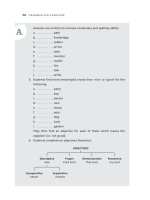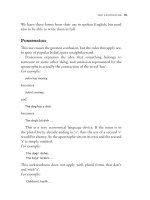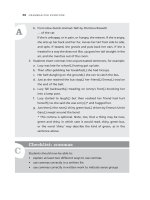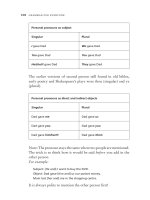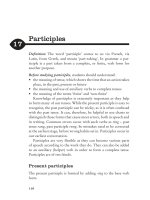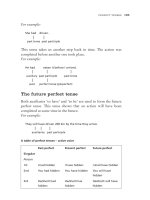Tài liệu Grammar for everyone part 22 pdf
Bạn đang xem bản rút gọn của tài liệu. Xem và tải ngay bản đầy đủ của tài liệu tại đây (153.13 KB, 7 trang )
Dashes
These are generally less formal than other kinds of punctuation
and more conversational. Lynne Truss suggests that they are more
friendly, as though they are welcoming the extra thought inside as
opposed to brackets which imply intrusion.
Dashes are used singly, as a comment added to the end of a
sentence, or double for one included within.
For example:
On went the pilgrims through the years – some on foot and some on
horseback. They went overseas – to Mexico we think – and were never
heard of again.
One dash can lead to a dramatic effect.
For example:
Something floated past the dinghy – it was a human hand!
Ellipsis
Definition: The word is via Latin from the Greek, ellipsis, meaning
‘coming short’ – hence an omission, and it is indicated by three
dots …
The omissions are mainly for two purposes.
• Leaving out something not relevant to the rest of the statement,
often in a quotation.
For example:
In Africa, while staying near the swamp, we contracted malaria.
In Africa …. we contracted malaria.
• For dramatic effect.
For example:
The glass shattered on the floor and a form appeared in the
window …
‘It’s … It’s … a g…ghost,’ she whispered.
137
M or e p u n c t u At i o n
C
A
20.2 Activities: punctuation
1. The best way to learn about the use of punctuation is by reading good
literature of various kinds. Students need to read aloud to appreciate
fully what the punctuation is telling them. This can be done in turns
around the class or by reading parts in plays and should be accepted as
a regular classroom activity. In this way, students become familiar with
punctuation use and appreciate its functions. Choose passages from
set texts, selected drama, political speeches or Shakespeare’s plays.
Allow students sometimes to choose texts themselves.
2. Students write a paragraph on a subject of their choice, in which they
demonstrate the use of one or more given punctuation mark.
3. Students are given sentences to punctuate, either with specified
marks or with those they themselves deem to be most suitable. The
following examples are taken from Victorian Readers IV Edition 1989.
Each one is a single sentence.
a. Mrs Cratchits made the gravy ready beforehand in a little saucepan
hissing hot.
b. His parents called him Robert Lewis Balfour Stevenson but when he
was older he preferred to spell his name the French way Louis.
c. Upon this my savage for so I call him now made a motion to me to
lend him my sword.
d. And Hereward was drenched says The Chronicle with wine and beer
and sorely baited and badgered.
e. I’m called William that’s the name you’ll have to call if you want any-
thing, just you say William and I’ll be round in a second my names
William and I’ve been here a matter of seven and thirty years.
Checklist: punctuation
Students should now be able to
• explain the usage for all forms of punctuation
• punctuate a sentence of average length and moderate complexity
• demonstrate the use of a variety of punctuation marks in their own
composition
138
G r A M M A r f o r e V e rY o n e
More pronouns
Before further study of pronouns, students should be sure of:
• the meaning of the term pronoun
• the fact that a pronoun takes the place of a noun and cannot be
used with it
• recognising and naming personal and demonstrative pronouns
There are some pronouns that are less easily categorised with-
out some explanation. It is important that students recognise that
they are pronouns and understand why that is so. While the names
of the subclasses do explain their functions this understanding is
more important than memorising their names.
Interrogative pronouns
Definition: ‘Interrogative’, from Latin interrogativus means,
simply, ‘questioning’. So interrogative pronouns not only take the
place of nouns, but also ask questions. In other words, the ques-
tioner wants to know something about a person or thing.
These pronouns, like others, take different forms according to
the part they play in the sentence.
For example:
As the subject:
Who – Who are you?
As the object:
(For a person) whom – Whom did you see?
(For a thing) what – What did you see?
Or object of a preposition – whom – At whom was it thrown?
21
139
Possessive pronouns
Whose was she holding?
Is it yours or mine?
Indefinite and distributive pronouns
Refer to the section ‘Subjects matching verbs’ on page 109.
To students whose knowledge of pronouns is limited to per-
sonal pronouns, indefinite pronouns do not, at once, seem to be
connected. The term indefinite pronoun is self-explanatory. Its
indefiniteness is shown by its referral to no one or no thing in
particular.
Indefinite pronouns
The following are most of the indefinite pronouns in common
use:
Persons things
one everyone everything
nobody no one nothing
anybody anyone anything
somebody someone something
For example:
Nobody could do anything.
Can’t somebody do something?
Distributive pronouns
These refer to one person or thing from two.
For example:
Either go now or stay at home.
Neither wants to go.
140
G r A M M A r f o r e V e rY o n e
A
Or to a group of two or more.
For example:
Each has a banana.
I gave each an apple too.
21.1 Activities: pronouns
1. Students write down the definition of a pronoun. After checking
the answers, a correct definition is written on the board. Individual
mistakes are corrected.
2. Students are asked to say when the words ‘those’ and ‘his’ are
not
pronouns.
3. Sentences are read out and students raise their hands when they
hear a pronoun. Some can also be written, for example:
a.
They went to a wedding.
b. Tom wore his best outfit.
c.
That is my favourite, said Lucy.
d.
Who was the best man?
141
M o r e p r o n o u n s
Each has a banana.
